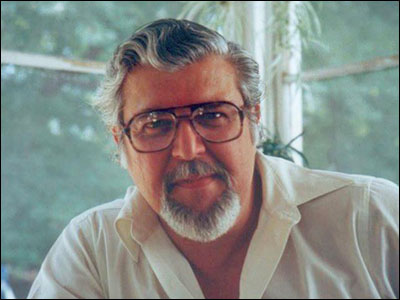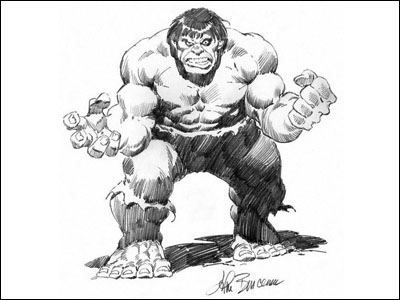Not long ago, I put up this post about the penciler/inker divide in American comic books and received this message from J.C. Lebourdais…
Longtime French follower of your writing here, both from comics and from the blog. I just read your reply about George Roussos and inkers in general and I have a follow-up question that's been in the back of my mind since I started reading American comics.
Here in Europe, the artists retain the rights to their own work and are able to decide whether they want to ink themselves, hire an assistant or have their own studio.
In U.S. comics, clearly, the publishers used to be in charge in the Silver Age, as you demonstrated, but I've always wondered why such powerhouses as Steve Ditko or Jack Kirby wouldn't simply ask the publisher to be paid for the full art, then hire their own inkers, pick some that would fit their style, their methods of working, etc. in order to be more in control of the finished product. I can't imagine that either of those comics legends just wouldn't care about artistic integrity, or just how it all looks once on the printed page.
Especially in light of some unfortunate pairings (I remember the stories you told about how Jack was notoriously unsatisfied with the inking on Thor, for example, or the touching up of Superman's face on the Fourth World books, I'm sure there are plenty more of those). Someone like Will Eisner seemed to have his own studio and deliver the publisher the whole package. Why wouldn't everyone else do the same?
Well, Will Eisner didn't work for DC or Marvel on properties they controlled. An "employer" — and I'm not using that word in a legal sense — wields considerable power because they're the ones who write checks and freelancers need to receive checks. That power was particularly potent in comics before 1970 because most of the Talent Pool consisted of men who'd grown up, often in poor families, during the Great Depression. Some of them were uncommonly terrified of unemployment and willing to tolerate bad deals and even a certain amount of personal abuse to not be outta work.
And they felt they had to work the way their editors wanted them to. A lot of artists who didn't want to be inkers were turned into inkers. A lot of pencilers saw their work consistently inked by inkers they felt ruined the pages. A lot of them didn't like the books to which they were assigned or the scripts they had to work on. But at times, the alternative was not having steady work and therefore not receiving steady checks.
I don't think writers and artists today are as timid about such matters. They also have a lot more comic book companies that might hire them and it's easier to move into other fields like videogames or animation.
No matter how valuable your services might be to your employer, that only translates into clout if they're afraid to lose you…and that means you need a viable alternative — somewhere else you could go and get equal or better pay and security. Too often, even the best writers and artists in comics didn't believe they had alternatives.
Kirby certainly didn't. In 1968, just to pick a year at random, he didn't see any other place he could work but Marvel. The other publishers of comic books then either didn't want him or paid much, much less…and he had a family to support. Jack actually didn't want to ink his own work and he didn't really care that much who did. He thought almost all his inkers were fine and that the product was not being harmed by an inker who you or I might have thought was not the best choice.
He did care about artistic integrity…as much as anyone and more than most. He just didn't think inking mattered that much and he also recognized that whoever was inking his work had a family to support, groceries to purchase, etc. About halfway through the Fourth World books, his view on this changed and for only the second time in his career — as far as I know — he asked to have an inker replaced. In this case, it was for one he wanted…and one who was more loyal to Jack than he was to DC Comics.
Steve Ditko actually did get the inker he wanted: Himself. For a long time, Stan tried to get Ditko to pencil-only…and he did do a few stories that way. It would have been better for Stan and Marvel, Stan thought, if instead of penciling and inking Spider-Man and Dr. Strange — a book and a half a month — Ditko had penciled (only) three books a month, thereby lending his plotting skills to more books. But Ditko refused.
As a reader, I'm kinda happy he did. I don't think anyone came close to inking Steve Ditko work as well as Steve Ditko. I feel that way about a lot of artists of the past. I wish more of them had been able to ink their own work without taking a financial hit. And I think there was and is a value to having writers and artists be happy in their assignments.
I hope it's okay to tell this story now. Around the turn of the century, I did a comic for DC called Fanboy, which was one of my favorite projects ever. It was six issues with Sergio Aragonés as the main artist and we had guest artists who included Neal Adams, Brent Anderson, Jordi Bernet, Brian Bolland, Dave Gibbons, Joe Giella, Mike Grell, Russ Heath, Phil Jiminez, Bob Kane (posthumously), Gil Kane, Joe Kubert, Kevin Maguire, Frank Miller, Jim Mooney, Kevin Nowlan, Jerry Ordway, Wendy Pini, Steve Rude, Marie Severin, Bill Sienkiewicz, Tom Simmons, Dan Spiegle, Dick Sprang, Bruce Timm and Bernie Wrightson.
With a lineup like that, you'd think the comic should have sold like crazy. Yeah, you'd think that.
But the response from the marketplace — and I hope this doesn't sound bitter because I honestly don't get bitter about things like this — was close to non-existent. Nobody bought it. Nobody even knew it existed. To this day, people at conventions come up to me with copies to get signed and they say, "I was reading comics when this came out. How come I didn't know about it?"
One day back then, I was up at the DC offices and one of the fellows in the marketing division stopped me in the hall and asked me if I was working on something for the company. I told him about Fanboy and mentioned the names of some of the "hotter" artists I'd been able to lasso for the project. He said, "That sounds great. When is it coming out?"
And I had to tell him that #5 of six had just been published. Talk about a tree falling in the forest and not making a noise.
But I enjoyed doing it because I enjoyed working with all these people and connecting with my passions as a reader of comics all my life. Jim Mooney was one of the artists in the very first super-hero comic I ever read when I was about eight — Action Comics #250.

We did an issue that had a long sequence involving Green Lantern and, of course, I wanted to have it drawn by the team that had drawn my favorite Green Lantern stories when I was young — Gil Kane inked by Murphy Anderson. I chanced to talk to Murphy first and told him what I had in mind. He said yes so I then called up Gil…
…and Gil said yes. That is, until I told him I was going to have Murphy Anderson do the inking. Then Gil said no.
Gil had never liked what Murphy did to his pencils. He was fond of Murphy personally and he thought Murphy was an excellent artist. In fact, he thought Murphy was one of those artists who should have always done both jobs. Gil just "saw" his own work differently. Gil Kane artwork inked by Murphy might have been pleasing to you or to me but it did not come out looking the way Gil thought his work should look. There were things he put in that were not there in the printed pages.
He said, approximately, "Back in the day, I didn't have any choice. Now that I have a choice, I want to choose." I asked him who he'd choose. He said he wanted to ink the cover himself and he wanted the interior pages he drew to be inked by Kevin Nowlan. I said, "If he'll do it, we'll have him do it." As I was saying that, I was cringing at the thought of the call I'd have to make to Murphy. This was a creative decision. If I had to pick between Kane and Anderson, I was going to go with Kane.
And then Gil said something that struck a chord with me and again, these words are roughly what he said…
He said, "I lived through the era when editors and publishers didn't care how unhappy I was on any assignment. If I said something, it was like, 'Gil, just draw the pages and shut up. Don't care so much about the work.' I wasn't supposed to utter a peep about bad lettering or bad inking or bad coloring or bad printing or if they had the worst artist in the Production Department retouching what I'd done. And the thing that got to me was that they didn't think that attitude — 'Just draw the pages and shut up' — would affect the quality of my work…
"But how could it not?"
Over the years, I was always fascinated with how all the talented writers and artists who made comic books were deployed…and why I might love what they did on one comic and then on another, maybe not so much. I learned that there's such a thing as miscasting artists. I also learned that an editor needs to create an environment that will allow others to do their best work. This is done in large part by treating others with respect and understanding. Gil probably did better work on those Fanboy pages once he knew they'd be finished by Kevin Nowlan — who happily agreed to participate.
And yes, I called Murphy. To my surprise and relief, when I told him what was going on, he said, "I don't blame him one bit. I didn't like inking his work back then. I never thought our styles were compatible. I never liked inking Carmine Infantino's pencils either and I knew he didn't care for what I did on them."
I got Murphy to instead agree to pencil and ink a Wonder Woman sequence I had planned for a later issue of Fanboy. As things turned out, he was unable to do it…and apologized way more than was necessary when he told me. Murphy Anderson personified the word "gentleman." He was one of the nicest, politest men I met in comics…and a great artist when he was allowed to be as good as he could be. Even when he felt misused, he was pretty good but that's no reason to misuse a guy like that.
Most of the editors in comics back then would not have wanted to sacrifice the power they wielded to put any inker with any penciler if it worked for their schedules. Like you, I would have liked for them to not have that power…or to care more about the freelancers being happy with how they were assigned. As I said in the earlier piece, I do think better comics would have resulted.






